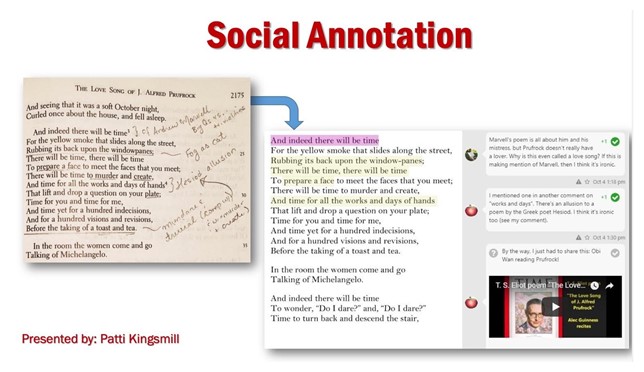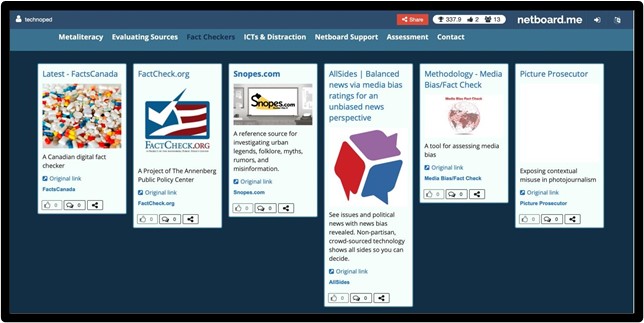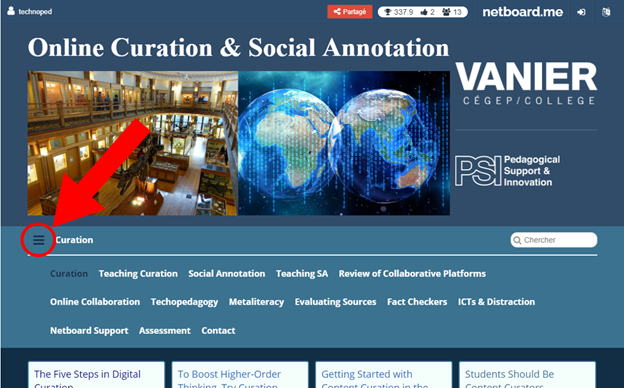A Crash Course on Online Curation and Social Annotation – An interview with Patti Kingsmill
Online curation (OC) and social annotation (SA) are 2 collaborative strategies that can help students make meaning of the course content and relate to it in an authentic way. For this article I spoke with Patti Kingsmill to find an easy way to implement these effective digital teaching methods.
Patti is a pedagogical counsellor at Vanier College and has been contributing to the development of resources for OC and SA since she began work on an Entente Canada-Quebec project in 2017. There is now a wealth of information on the topic both on the Vanier College’s Pedagogical Support & Innovation page and on the SALTISE OC and SA Community of Practice page.
Definition of online curation & social annotation
Online curation and social annotation are peer-teaching strategies that engage students collaboratively in online environments. Online curation entails the collecting, organizing, annotating and sharing of relevant content with others. Social annotation involves collaborative discussion of media (texts, videos, images) in a cloud-based environment.
Online curation
According to Vanier Academic Voices (page 6), online curation is:
- purposefully collecting online content on a given topic;
- selecting the most relevant or interesting information;
- summarizing its significance for the collection;
- organizing it;
- sharing it on a cloud-based platform.
Patti explains that curation is not just gathering sources and “dumping” them in a shared space. Students have to explain
- why they choose this source
- what role this source plays in the overall curated piece
Students can curate individually or collaboratively.
You’re asking them to think deliberately about a particular perspective on a topic, the relevance of each piece to that perspective, the validity of each source, and its appropriateness for the audience.
Patti mentions that in order to curate well, students have to learn how to consume media critically to curate effectively and that social annotation is a way to help them learn to do so.
Social annotation
Social annotation transforms curation into a peer-teaching experience. Social annotation does not need to happen in association with curation. It’s just that SA helps students learn to read or view critically, something that is important as they curate.

SA digital platforms allow students to have conversations in the margins of the texts they are reading or alongside video or images they are viewing. They can give and receive feedback from their teacher and peers.
Source: Power Point Presentation Introducing Social Annotation. (Screenshot by the author)
Together, students support one another in understanding or deepening their understanding of the discourse (text, video, or image). They can benefit from reading the multiple viewpoints of their peers. Cloud-based, social annotation platforms not only allow students to comment on elements of a discourse, but also on each other’s comments. They can add links, images, and videos to their comments and replies, thus enriching their grasp of the discourse’s significance.
In Patti’s experience, “Working in a collaborative context where you know that your peers are going to look at what you’re doing, can impact student motivation and engagement. Students have told their teachers, ‘If I were just sharing with you, I might not take as much care, but if I am sharing with my classmates or my friends I want to put in additional effort’. All of a sudden it matters more, and they want to do a better job. Curating in a collaborative context seems to up the stakes. Another point that might be worth adding here is that it lends authenticity to the assessment because in the real world students may need to share their work online or at least with colleagues.”
Platforms for Online Curation and Social Annotation
Online teaching and learning may leave some teachers and students feeling a little overwhelmed at having to learn so many platforms. However, if your students and you are already comfortable with the basic platforms (Teams, MOODLE, etc.), Patti thinks it would be a really good time to start using an OC or SA platform. It engages students in their own learning in a much more proactive way. They are not just passively doing something; they’re taking ownership of their own work.

Sample Netboard.me containing texts on Fact-Checkers. Source: Online Curation & Social Annotation, Pedagogical Support and Innovation. Vanier College. (Screenshot by the author)
Here is a review of various platforms that can be used for OC and SA:
- Online curation:
Patti Kingsmill recommends Netboard.me. Somewhat similar to Padlet, Netboard is free and has an educational environment (called an organizational account) that allows you to upload class lists and put students into groups. It allows students to create their own board or you can create boards for the students. It’s very flexible and allows for board customization.
The Netboard.me Support page provides several instructional videos. It is not hard to learn to use this platform, and definitely worth the investment in time.
- Social annotation:
- Hypothes.is
- Perusall
- Classroom Salon
- Yuja (has an excellent video commenting feature)
Tips on how to use OC & SA with Netboard in your class
Netboard is great, says Patti, because you can create a class and have multiple boards. Your students can either have:
- individual boards where they choose pieces that they want to share with their team
- a team board. Students could work on multiple tabs and leave the first tab (the main page) as the place to put their final product.
Teachers could ask students, for example, to look for some good sources, and write a brief annotation with each one, justifying why they think the team should include it. Team members could give feedback on each other’s choices according to set criteria.
Getting started
Go to the Online Curation & Social Annotation page. Click on the hamburger icon (see arrow below) to find a wealth of information on OC and SA.
It is not necessary to read everything immediately, if you would like to rapidly implement this strategy. The “teaching curation” and “teaching social annotation” would be 2 pages that you don’t want to miss because these are the teaching tools. On each page there is:
- An explanation of the strategy in a PowerPoint presentation
- A guide to integrating the strategy into your classroom
- A sample activity
- A sample descriptive rubric (that is very detailed) and a holistic rubric
Assessment
Some teachers have been wondering how to deal with assessment in an online context to avoid plagiarism. Curation can be an effective way to mitigate it, since it requires students to not only produce a finished product, but to go through a process that includes peer and teacher review. It also requires students to create something that is uniquely their own—their own remix of work with their own perspective and reflections.
You can have students work in teams and either interview them afterwards individually, or ask them to write self reflections in which you ask them to discuss the work they did. They could be asked to justify in more detail their source choices, or which ones they believe are the strongest. They could be asked to reflect on what they feel they learned overall on the topic and what sources interested them the most and why. They could be asked to reflect on peer feedback—the benefits they gained from receiving or giving it. There are ways of getting students to self-assess to ensure that they actually did do some work and that they understood.
The Takeaway
Using OC and SA allows students to create evidence of learning (like leaving a trail of breadcrumbs on their learning path) that allows teachers to assess the learning process.
You can follow the learning process and see just what role your students are playing in that process. By the time they finish, they have collaboratively done a more in-depth research paper that they would have been able to do if they had done it individually on their own, and they’ve learned to collaborate and to work in a digital environment, which are some of the outcomes of the Plan d’action numérique
Acknowledgments
Pedagogical counsellors have been really busy helping teachers with the shift to remote teaching, which is why I would truly like to thank Patti Kingsmill for taking time off her busy schedule to collaborate with me on this article.
Further reading:
- Kingsmill, P. (2018) Exploring Online Curation and Social Annotation Platforms. VTÉ
- Kingsmill, P. (2019) Integrating Online Curation and Social Annotation into Courses. VTÉ
- Kingsmill, P. et al. (2020) Developing 21st Century Skills with Online Curation and Social Annotation pages 6 to 11, Vanier Academic Voices. (Testimonials by 3 teachers)
- Collaborative Platforms For Curation And Annotation (Reviews presented by the pedagogical support and innovation office of Vanier College)


